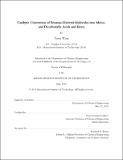| dc.contributor.advisor | Yuriy Román-Leshkov. | en_US |
| dc.contributor.author | Wang, Yuran | en_US |
| dc.contributor.other | Massachusetts Institute of Technology. Department of Chemical Engineering. | en_US |
| dc.date.accessioned | 2016-09-13T18:07:15Z | |
| dc.date.available | 2016-09-13T18:07:15Z | |
| dc.date.copyright | 2016 | en_US |
| dc.date.issued | 2016 | en_US |
| dc.identifier.uri | http://hdl.handle.net/1721.1/104122 | |
| dc.description | Thesis: Ph. D., Massachusetts Institute of Technology, Department of Chemical Engineering, 2016. | en_US |
| dc.description | This electronic version was submitted by the student author. The certified thesis is available in the Institute Archives and Special Collections. | en_US |
| dc.description | Cataloged from PDF version of thesis. | en_US |
| dc.description | Includes bibliographical references. | en_US |
| dc.description.abstract | Biomass can serve as a renewable alternative to the inevitably depleting fossil fuel resources and provide feedstocks for the production of fuels and chemicals. Mono- and dicarboxylic acids and esters are key intermediates to chemical products, especially for biodegradable polymers. This thesis has addressed the challenges in chemocatalytic synthesis of mono- and dicarboxylic acids and esters, including gluconic acid, succinic acid, itaconic acid and their esters, from biomass-derived molecules. Gold (Au) catalysts have been rarely investigated for the oxidation of glucose in the absence of a base. These conditions are critical, however, to enable the sequential one-pot combination of cellulose hydrolysis and glucose oxidation. The study provides insights into the deactivation of the catalysts caused by leaching and hydrothermal sintering of Au nanoparticles, as well as by adsorption of reaction species. We found that lowering the surface density of Au on metal oxides decreases the sintering rate of the Au nanoparticles and hence enhances the stability and activity of the catalyst. Levulinate derivatives are an attractive platform for the production of renewable chemicals. We report on the oxidation of methyl levulinate into dimethyl succinate with peroxides under mild conditions using Bronsted and Lewis acid catalysts and focuses on the reaction selectivity control. While the molecular structure (i.e., carbon chain length and branching around the C=O group) and the oxidant type affect the product distribution, solvent choice has the strongest impact on changing the location of oxygen insertion into the carbon backbone. In contrast to Brønsted acids, for water-tolerant Lewis acidic triflate salts, the reaction selectivity is affected by the size of the metal cation. We have developed a novel approach to synthesize unsaturated dicarboxylic acid esters via aldol condensation of keto esters catalyzed by Lewis acidic zeolites. Hafnium-containing BEA (Hf- BEA) zeolites are highly active, selective and stable for the condensation of ethyl pyruvate into itaconic acid ester analogues. Analysis of the dynamic behavior of Hf-BEA under flow conditions and studies with Na-exchanged zeolites suggest that Hf(IV) open sites possess dual functionality for Lewis and Bronsted acid catalysis. | en_US |
| dc.description.statementofresponsibility | by Yuran Wang. | en_US |
| dc.format.extent | 114 pages | en_US |
| dc.language.iso | eng | en_US |
| dc.publisher | Massachusetts Institute of Technology | en_US |
| dc.rights | M.I.T. theses are protected by copyright. They may be viewed from this source for any purpose, but reproduction or distribution in any format is prohibited without written permission. See provided URL for inquiries about permission. | en_US |
| dc.rights.uri | http://dspace.mit.edu/handle/1721.1/7582 | en_US |
| dc.subject | Chemical Engineering. | en_US |
| dc.title | Catalytic conversion of biomass-derived molecules into mono- and dicarboxylic acids and esters | en_US |
| dc.type | Thesis | en_US |
| dc.description.degree | Ph. D. | en_US |
| dc.contributor.department | Massachusetts Institute of Technology. Department of Chemical Engineering | |
| dc.identifier.oclc | 958140263 | en_US |
